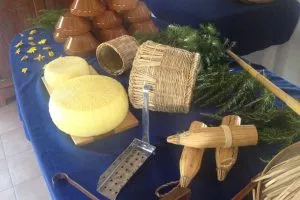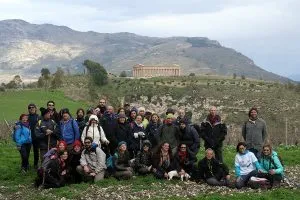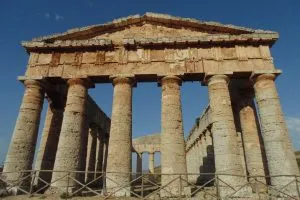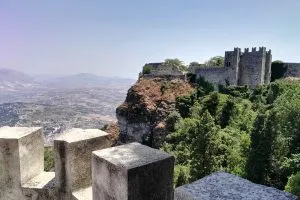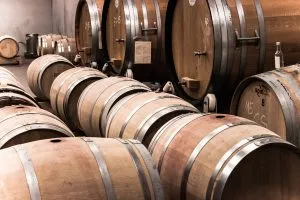Private vehicle disposal: full day from h 8.30AM
Local Hiking Staff: includedBreakfast at hotel.
Today departure to explore
EriceTour #1 | Pepoli Tower and Erice Route
Hiking Details: Km: 3 | 120 mt elevation gain
Introduction: Cyclopean walls, ancient castles and historical buildings, and then the visit to the hamlet of Erice, with its artistic and traditional craftsmanship and its almond sweets.
Level of Difficulty: Easy Hiking Tour. Good fitness required. Mostly accessible paths





We are on the top of Mount Erice, in the square that takes its name from the nearby Chiesa di San Giovanni (church of St. John), one of the oldest churches of Erice. This church, from where you can enjoy a breathtaking view, is recognizable by its white dome that stands out at the eastern tip of Erice. Its original structure it is thought to date back to the 12th century; the church has been restored and extended several times, while featuring its suggestive entrance portal in Late-Gothic style; now it is a modern auditorium which preserves some masterpieces of Renaissance art. From the square, a walkway leads to the Torretta Pepoli (Pepoli Turret), dating back to the 19th century and built by count Agostino Pepoli (not accidentally named after him). Built on a cliff in a charming panoramic position (stretching from the gulf of Bonagia to Trapani and its saltpans), this characteristic Art Nouveau building was intended for meditation and study. Today the Turret, after an accurate restoration, has regained its original beauty and can be visited.
The Castello Normanno (Norman Castle) rises majestically on an imposing rocky outcrop; below a pine forest (created by count Pepoli who wanted to breathe ‘balmy air’) surrounds the area. The Castle was built over the remains of the ancient temple of Venere (Venus), a sacred building erected by the Sicanian-Elymians (9th-8th centuries b.C.) for the worship of the goddess of fertility, as well as a place of devotion for the Mediterranean peoples.
Placed as a defence to the valley below, the castle was built in the 12th century AD by the Normans. The doorway is characterised by an ogival arch and topped by a commemorative plaque depicting the eagle of the Hapsburg monarchy. Besides its defensive function it also housed the prisons which are still visible. Today it is used as a place for cultural exchange: during summer nights it’s easy to be enchanted by listening to music, poems and old songs, enveloped in a seductive atmosphere.
Then the path continues in a south-westerly direction to Porta (Gate) Trapani, one of the three gates to Erice through the Cyclopean walls.
Tour #2 | Saint Anna RouteHiking Details: Km: 6 | 680 mt elevation gain
Introduction: Full steam ahead with nature! Between woods and forests to reach the summit, the ancient Medieval town of Erice, one of the most beautiful villages in Italy.
Level of Difficulty:The first thing to say is that this part of the hike should not be attempted unless you are experienced and physically fit.




 The route reaches the top of the mountain where is located the ancient medieval village of Erice.
The route reaches the top of the mountain where is located the ancient medieval village of Erice.After a short urban stretch along Via Capua, Via Manzoni, Via Pola and Via Sant’Anna, you can easily reach the entrance of the Martogna picnic area, within the “Monte (Mount) Erice” wooded area, characterised by Mediterranean pine trees, oaks trees and eucalyptus trees. The area is also equipped with wooden benches and tables, a picnic area, a children’s playground and an area with different animal species (including goats from Tibet, fallow deer, donkeys from Pantelleria and many species of birds).
In the second stretch the path rises towards Pizzo Argenteria (where a breathtaking view over Trapani can be admired) and then it reaches the Sanctuary of Sant’Anna (332 m.), whose construction dates back to the 17th century. For centuries it was a pilgrimage site by the devotees of Sant’Anna. Now it is a place of silence and prayer offering unique views of the extreme western tip of Sicily, Trapani, the Egadi islands and the crossroad of the two seas: the Thyrrenian and the Mediterranean.
The path continues on for about another kilometer until the Forestry Commission Building; it goes through a wood towards Porta (Gate) Trapani, one of the three gateways to Erice, so named because it looks towards Trapani. It is also an evidence of the Cyclopean fortification walls (8th-7th centuries b.C.) of Erice
Approximately 5,5 kilometers to reach one of the most beatiful hamlets of Italy, to visit historical and artistic monuments such as the Castello Normanno (Norman Castle, 12th -13th centuries), the Torretta Pepoli (Pepoli Turret, 19th century), the Duomo dell’Assunta (the Main Church dedicated to the Assumption of the Virgin Mary, 14th century) –to name but a few- or to delight your palate with the typical sweets from Erice, such as those made of almond paste, the so called “genovesi” or the “mustazzoli”, or to go shopping walking along the narrow streets: do not miss the trappiti (the traditional carpets) and the hand painted pottery, evidences of an artistic handicraft handed on from generations.
During the afternoon we travel to Marsala region along the Salt Way Road. While travelling we will be fascinated by this unusual landscape: panels of mirror-like water, held by thin strips of earth and white windmills. In Summer now as then in some areas between Trapani and Marsala it is possible to admire piles of salt just harvested.
END our services.
![]()
![]()
![]()
![]()
![]()

 DEUTER
DEUTER

